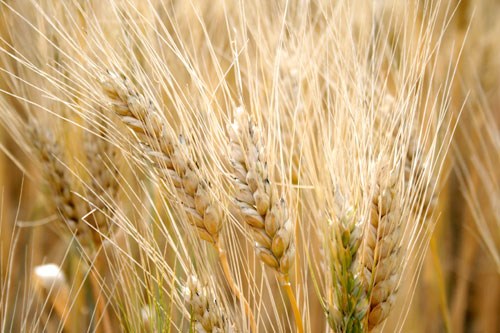Just over five per cent of the 2010 crop has been combined in the southeast, ahead of the provincial level of two per cent, with warm weather needed to help push the crops along, as crop maturity has been slowed due to cool, wet weather conditions. Many areas are still one to two weeks behind normal in crop development with wet fields causing problems for the combine, according to Saskatchewan Agriculture's weekly crop report.An additional nine per cent has been swathed or is ready to straight combine. The southeast region has five per cent of the crop combined and 18 per cent of the crop is swathed or ready to straight-cut. My crops are looking below average, expressed Kevin Aasen, a farmer in the Weyburn area.The five-year provincial average, 2005 to 2009, for this time of year is to have 12 per cent combined and 19 per cent swathed or ready to straight combine. The wet and cool weather has delayed crop maturity and slowed harvest. As producers put their swathers and combines into the fields, they are finding more water than they had originally anticipated in some areas.Jeff Gaab, a farmer south of Weyburn, has begun harvest. Gaab has swathed his canola and lentil crops and has combined peas and some canola and is beginning to combine lentils. We've got a nice start; we have combined all our pea crops with probably 10 to 15 per cent combined, explained Gaab.So far the crops are looking good. Canola has been quite satisfying with those yields along with the peas, which turned out good too. In the southeast there is 28 per cent of winter wheat standing, five per cent in swath, 33 per cent ready to straight combine, 34 per cent combined and one per cent is rated as other. There is 26 per cent of fall rye standing, nine per cent in swath, 23 per cent ready to straight combine, 42 per cent combined and eight per cent rated as other.Spring wheat in the southeast has 90 per cent standing, six per cent in swath, three per cent ready to straight combine and one per cent combined. Durum is 91 per cent standing and nine per cent in swath; oats is at 94 per cent standing, four per cent in swath, two per cent ready to straight combine and two per cent is rated as other.There is 84 per cent of the barley crop standing, nine per cent in swath, four per cent ready to straight cut and three per cent combined. Lentils has 67 per cent standing, 12 per cent in swath, seven per cent ready to straight combine and 14 per cent combined; pea crops are 49 per cent standing, nine per cent in swath, 18 per cent ready to straight combine and 24 per cent combined.Canola crops in the southeast are standing at 59 per cent, 36 per cent in swath, four per cent ready to straight cut and one per cent combined; mustard crops are at 67 per cent standing, 21 per cent in swath, one per cent ready to straight combine and 11 per cent combined.Cropland topsoil moisture is rated as 29 per cent surplus, 69 per cent adequate and two per cent short. My fields are on the wet side, but they're still manageable unlike other areas, said Gaab.Aasen has excessive moisture on his cropland; topsoil moisture has caused damage to his crops, along with hail that didn't cause too much damage. According to the crop report, the majority of crop damage is 小蓝视频 caused by flooding, wind and disease. Quite a while ago we had a hail storm come through, but the damage was nothing major. There hasn't been any (crop damage) so far, we're managing fairly well, said Gaab.The recent rain is raising concerns about disease ripening pulse crops. Sprouting and bleaching in swathed cereals is also a concern. There are a few farmers controlling aphids in canaryseed.Cropland topsoil moisture conditions are now reported as 36 per cent surplus, 63 per cent adequate and one per cent short. On hayland and pasture, topsoil moisture is rated as 21 per cent surplus, 76 per cent adequate and three per cent short. On the Gaab's hay land, they were able to finish the hay they wanted to put up and turned out to be fairly good quality. Crop District 1B is reporting 51 per cent of cropland has surplus topsoil moisture.Haying continues in southeast Saskatchewan but rain and heavy dew continue to slow the progress. In southeastern Saskatchewan 96 per cent of the hay crop has been cut, 88 per cent of this has been baled or put into silage and eight per cent is in the swath. Baling hours were cut short due to humidity in the evenings. Quality is rated as 19 per cent excellent, 50 per cent good and 15 per cent fair. Depending on when and how much rain fell, hay quality is rated from excellent to poor.Pasture conditions have improved since last month and are rated as 53 per cent excellent, 43 per cent good and four per cent fair. There has been 99 per cent of producers reporting adequate supplies of livestock water. Foot rot is still causing problems in cattle herds.Farmers have started cutting greenfeed crops and are haying, harvesting, getting ready for harvest and controlling weeds on unseeded acres. Last week, most of the region received heavy rains with all areas reporting rain in amounts ranging from two to 108 mm.The Weyburn area received 67 mm and the Indian Head and Radville areas received 50 mm. Most areas reported in excess of 25 mm of rain.One year ago, just over three per cent of the 2009 crop had been combined, 11 per cent of the lentils and 18 per cent of the peas had been combined. Haying was wrapping up and harvest progress was slow due to rain showers in many areas of the province.
